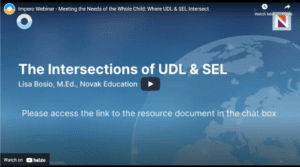Social and emotional learning (SEL) is an integral part of education and human development and is a popular topic of conversation for educators. Universal design for learning (UDL) is a learning concept about removing barriers to improve teaching and instruction, leading to better outcomes. It’s important for educators to understand how imperative social and emotional learning is for students in the learning environment. By integrating Universal Design for Learning (UDL) and Social Emotional Learning (SEL) practices into their day-to-day teaching, educators can better support students and teach them how to work more productively with their peers.
Recently, Impero hosted a webinar with Novak Education called “Meeting the Needs of the Whole Child: Where UDL & SEL Intersect.” In this session, Lisa Bosio, M.Ed shared strategies on how to create a learning environment that fosters social, emotional, behavioral and academic growth using UDL and SEL.
Here are some ways you can create a more supportive learning atmosphere with UDL and SEL:
Utilize CASEL’s 3 Signature Practices
Since its introduction more than two decades ago, the Collaborative for Academic, Social, and Emotional Learning (CASEL) has been a leader in SEL. CASEL has aided in the development of SEL from a promising hypothesis to an important component of education. They are ideally positioned to review programming, curate research, inform legislation, and cooperate on implementation as a nonprofit, nonpartisan leader in SEL.
– Introduce welcoming rituals and inclusion activities. Welcoming routines at the beginning of the day include tasks or actions that are performed everyday such as a to “Do Now” task prompt on the board as students enter the classroom, or a mood meter for students to express their feelings in the morning (for example, asking students “Write down what you are feeling currently” as they enter the classroom). As with other classroom routines, practicing these procedures is an investment in building a peaceful, orderly environment in which students can move with confidence and agency. A friendly greeting of every student at the door is an example of a welcoming ritual in a classroom.
– Include engaging strategies, brain breaks, and transitions. Engaging strategies are organically integrated with SEL and consist of sequential processes that can enhance individual learning (such as the use of “turn-to-your-partner”). Being aware of and attentive to neurological, biological, social, and emotional demands is the goal! Brain breaks are critical for anchoring learning, recovering focus, and increasing creativity. Schedule specific brain pauses to process material and allow time for sense-making if a class hour or meeting is primarily lecture / directed input. Transition techniques indicate changes during a class period or a school day and should be introduced shortly before changing activities within a class period or school day. Transitions can include routines such as “five minutes before we…”. These are beneficial approaches for everyone, especially for those who have processing issues or who have had traumatic events that damage their social and learning experiences.
– End the day with optimistic closure activities. An optimistic closure emphasizes an individual’s and group’s appreciation of the day’s activities, which can give a sense of success and encourage forward thinking. Optimistic closures can be reflective of the learning, aid in the identification of the next stages, or establish connections to one’s own work.
Build Relationship Skills
There are a few easy ways to build meaningful relationships in the classroom, such as:
- Developing familiarity with students by seeing them in familiar everyday settings such as at recess, lunch, community events.
- Connect with students by sharing similar interests, hobbies and passions. This allows for a bond to be formed beyond racial, class, or linguistic differences.
- Show concern for issues and events important to students. Remembering specific details about them will plant the seed of personal regard.
- Be intentional about speaking to students with empathy.
Want to learn more? Watch the whole webinar here, which provides additional information and resources to support students using UDL and SEL.
Looking for more resources? Here are a few to help support students in any learning environment:
- Supporting Student Mental Health in Remote Learning E-book
- Here’s How K-12 Can Benefit from Classroom Management Software Blog
- 5 Ways to Recapture Class Time and Keep Students On-Task with Classroom Management Tools Blog
Impero Software is a leading provider of classroom management, online student safety, web filtering and secure remote access software. Our technology has the power to help people learn, work and connect safely online. At Impero, we believe it’s important to not only provide best-in-class software but also resources for educators. To learn more, get in touch.



